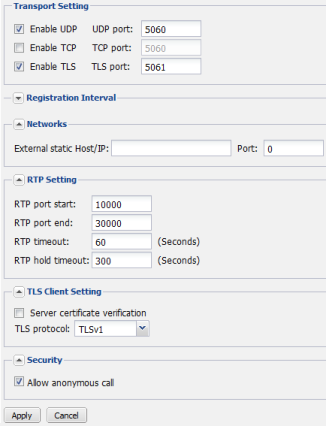Figure 17: SIP settings


GUI field | Description | |
Transport Setting | SIP communication commonly uses TCP or UDP port 5060 and/or 5061. Port 5060 is used for nonencrypted SIP signaling sessions and port 5061 is typically used for SIP sessions encrypted with Transport Layer Security (TLS). Enable the ports as required. | |
Registration Interval | ||
Extension registration interval range | To keep the extensions’ registration status with the FortiVoice unit, enter the range of extension registration time interval as required by the FortiVoice unit in minutes. An extension’s registration timeout setting is overridden by the FortiVoice unit’s extension registration time interval range if it is out of the range. The default range is 1-480. The start of the range is 1-60 and the end of the range is 30-1440. | |
Internal extension registration interval | Enter the default registration time interval for the extensions on your subnet as required by the FortiVoice unit in minutes. The default is 30 and the range is 10-480. Set a proper value for this option. If it is too low, the performance of the FortiVoice unit is compromised due to frequent registration. If it is too high, the connection bewteen the FortiVoice unit and the extension may terminate. | |
External extension registration interval | Enter the default registration time interval for the extensions on other subnets as required by the FortiVoice unit in seconds. The default is 30 and the range is 10-1800. Set a proper value for this option. The FortiVoice unit requires that external extensions register more frequently with it to keep the connection. However, if the value is set too low, the performance of the FortiVoice unit is compromised due to frequent registration. If it is too high, the connection bewteen the FortiVoice unit and the extension may terminate. | |
Networks | ||
External static Host/IP | Enter the FortiVoice unit’s external static IP address to which the external extensions register. Also enter the port number. | |
RTP Setting | ||
RTP port start | Enter the starting Real-time Transport Protocol (RTP) port that the FortiVoice unit will use for phone call sessions. If the unit is behind a firewall, these ports should be open. Ensure there is a reasonable port range so that you have enough ports for all open calls. The default port is 5000. | |
RTP port end | Enter the end RTP port that the FortiVoice unit will use for phone call sessions. Ensure there is a reasonable port range so that you have enough ports for all open calls. The default port is 30000. | |
RTP timeout | Enter the amount of time in seconds during an active call that the extension will wait for RTP packets before hanging up the call. 0 means no time limit. The default is 60. | |
RTP hold timeout | Enter the amount of time in seconds that the extension will wait on hold for RTP packets before hanging up the call. 0 means no time limit. The default is 300. | |
TLS Client Setting | If you have enabled TLS, configure the following: • Server certificate verification: Select this option for the TLS clients to confirm the validity of a server’s credentials with a trusted root certification authority’s (CA’s) certificates. For information on uploading a CA certificate, see “Managing certificate authority certificates”. • TLS protocol: Select the TLS protocol version. | |
Security | By default, the FortiVoice unit screens out calls from callers who have blocked their caller ID information. If you want to change this default setting, select Allow anonymous call. | |